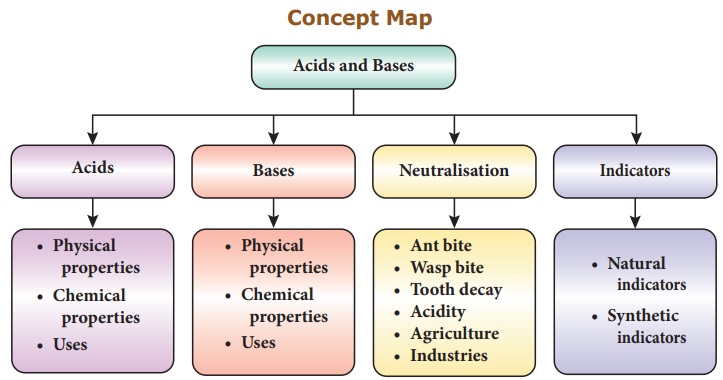Acids and Bases | Chapter 14 | 8th Science - Points to Remember, Glossary, Concept Map | 8th Science : Chapter 14 : Acids and Bases
Chapter: 8th Science : Chapter 14 : Acids and Bases
Points to Remember, Glossary, Concept Map
Points to Remember
* Acids produce H+ ions
when they are dissolved in water.
* Acids are generally corrosive in
nature and sour in taste
* All dilute acids react with
metallic oxidesto form respective metallic salts and water.
* Natural acids (organic acids) and
mineral acids are the two types of acids.
* Acetic acid and benzoic acid are
used as food preservatives.
* Sulphuric acid is known as king of
chemicals.
* Bases are the substances that give
hydroxide ions (OH–) on dissolving in water.
* Bases which are soluble in water
are called alkalis. All alkalis are bases but all bases are not alkalis.
* Bases are generally corrosive in
nature. They give soapy touch only in aqueous medium not in dry nature.
* Bases are used in paper
industries, textile industries and in the preparation ofmedicines. They are
used to manufacture fertilizers, nylon, plastics and rubber.
* When acids and bases are mixed
together in aqueous solution, they react chemically to produce salt and water.
This is known as neutralisation reaction.
* An indicator is a chemical
substance (either natural or artificial) which indicates the end of a chemical
reaction by a suitable colour change.
* Extracts of turmeric powder,
hibiscus, beet root and vegetables are used as natural indicators.
Phenolphthalein and methyl orange are artificial indicators.
GLOSSARY
1.
Acid A substance which
contains one or more replaceable hydrogen atoms.
2.
Alkali Water soluble
bases.
3.
Base A substance that releases hydroxide
ions when dissolved in water.
4.
Indicator Chemical substance
which indicates the acidic or basic nature of asolution by suitable colour
change.
5.
Inorganic acid Acids
produced artificially in industries.
6.
Natural indicators Substances
obtained from plants and used as indicators.
7.
Neutralisation reaction Reaction
between an acid and a base which produces water and salt.
8.
Organic acid Acids
which occur naturally in fruits and vegetables.
9.
Synthetic indicators Artificially
produced indicators
Concept Map

REFERENCE BOOKS
1. Petrucci, Palph Het.al. General
Chemistry: Principles & Modern Applications (9th Edition). Upper Saddle
River, NJ: Person Prentice Hall, 2007. Prinit.
2. P.L.Soni, Text book of Inorganic
chemistry, S.Chand publication, New Delhi.
3. Complete Chemistry (IGCSE), Oxford
university press, New York.
4. Raymond Chang. (2010). Chemistry,
New York, NY: The Tata McGraw Hill Companies. Inc.
5. Frank New Certificate Chemistry.
McMillan Publishers.
INTERNET RESOURCES
2. https://
www.khanacademy.org/science/ chemistry/acids-and-bases-topic
3. https://
www.khanacademy.org/science/ chemistry/neutralization
4. https://courses.chemistry/chapter/acids-and-bases
Related Topics